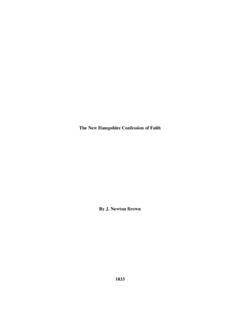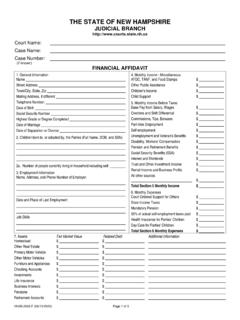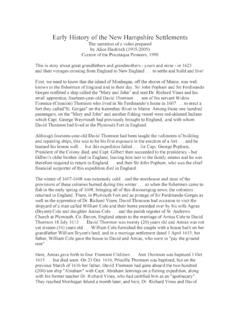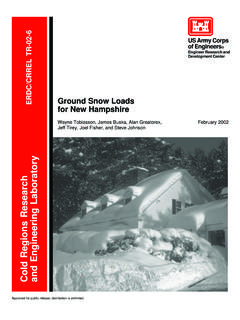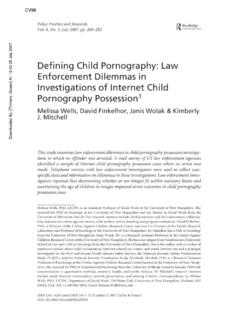Transcription of The STaTe of New hampShire’S Birds - NH Audubon
1 The STaTe of New hampshire SBirdsa CoNServaTioN GuideA report on the status of New hampshire s Birds , the challenges they face, and the actions we can take to help them. The STaTe of New hampshire s Birds A Conservation GuideWritten byPamela D. HuntMargaret B. WatkinsRebecca W. SuomalaAcknowledgements Special thanks are due to those who reviewed this publication: Paul Nickerson, Larry Sunderland, Carol Andrews, and Susan MacLeod. Thanks also to Carol Foss and Michael J. Bartlett for their review and support. We very much appreciate the photographers who allowed us to use their work throughout the are grateful to the Biber Foundation and the Butler Foundation for their financial support of this publication. The original technical report on which it is based was developed with funding from the New hampshire Fish and Game guide is based on the technical report by Pamela D. Hunt, The STaTe of New hampshire s Birds , produced by New hampshire Audubon and the New hampshire Fish and Game Department in 2010 and available at This guide is also available on the web at STaTe of New hampshire s Birds A Conservation Guide should be cited as follows: Hunt, , Watkins, Suomala.
2 2011. The STaTe of New hampshire s Birds A Conservation Guide. New hampshire Audubon , Concord, in New hampshire using soy-based inks on recycled paper with 50% post-consumer waste and manufactured using renewable Biogas hampshire Audubon : Protecting New hampshire s natural environment for wildlife and for people. New hampshire Audubon provides educational programs for children and adults, protects wildlife habitat, conducts conservation research and monitoring, and is a voice for sound environmental Silk Farm Road n Concord, NH 03301 n 603-224-9909 n 2011 New hampshire Audubon (NHA).No part of this publication may be reproduced in any way without the written permission of New hampshire cover: Purple Finch; photograph by Greg cover: New hampshire Audubon Biologist Becky Suomala at Pondicherry Wildlife Refuge; photograph by Julie Design and Production: Tricia Miller, MillerWorks, Portsmouth, STaTe of New hampshire S Birds 1 ContentsA Bird Population Primer.
3 2 Why Pay Attention to Birds ? ..2 Some Bird Basics ..3 Knowledge is Power ..4 How Are our Birds Doing? ..5 Overview of Current Trends ..5 Findings and Recommendations by Habitat ..7 Spruce-Fir Forest ..8 Hardwood/Mixed Forest ..10 Shrublands ..12 Grasslands ..14 Marsh and Shrub Wetlands ..16 Lakes and Rivers ..18 Coastal Habitats ..20 Developed Areas ..22 Riparian Edge ..24 Aerial Insectivores ..25 Additional Considerations ..26 Non-habitat Threats ..26 Beyond Our Borders: Birds in the Non-Breeding Season ..27 What You Can Do to Help Conserve new hampshire s Birds ..28 Conservation Goals ..28 As an Individual ..29 As the Owner or Manager of Forest Land, Farmland, or a Wetland Habitat ..31 As a Community Official ..31 As a Business Owner ..32status of new hampshire s Breeding Birds ..33 Glossary* ..35 For More Information ..36 The STaTe of New hampshire SBIrDsa CoNServaTioN GuidePamela D . HuntMargaret B . WatkinsRebecca W . Suomala*Terminology in the text shown in bold can be found in the Glossary.
4 2 The STaTe of New hampshire S birdSWhy Pay Attention to Birds ?We can see wild Birds virtually every-where in New hampshire . They are a familiar, highly visible part of our urban, suburban, rural, and wilderness land-scapes. They are also an integral part of our ecosystem. Birds can tell us about our environment, and what the Birds are telling us may be important, not only to their survival but to ours. How New hampshire s Birds are faring reflects on our stewardship of the earth and our impacts on it, both positive and specifically, Birds offer us poten-tially life-saving information about the en-vironment we share with them. We learned, for example, from canaries in coal mines when deadly gases were life-threatening and from thin shelled eagles eggs the ex-tent to which DDT permeated our environ-ment. Birds help keep insect populations under control, safeguarding agricultural crops and forests, and even us. The habitats Birds rely on forests, wetlands, lakes, and fields provide us essential services by fil-tering pollutants, helping to control climate change, containing flood waters, providing water supplies, food, and wood products.
5 Plus, people like Birds . We like protecting them, watching them, feeding them, hear-A Bird Population Primering them, and we anticipate their return in the spring and their fall exodus. For many of us, Birds bring joy. And for many people, the fate of Birds and other life forms on earth is a responsibility that we humans are uniquely qualified to 2010, New hampshire Audubon and the New hampshire Fish and Game Department issued a technical report, The STaTe of New hampshire s Birds . That document looked at population trends for the 186 species known to breed in New hampshire . It reviewed what we know about the reasons behind those trends and recommended conservation actions to limit population declines. This publication, The STaTe of New hampshire s Birds A Conservation Guide, presents the results of that report in a less technical, easy to understand format to broaden the audience. Above: Blackburnian May MedLockLen MedLockThe STaTe of New hampshire S Birds 3 Some Bird BasicsBird Populations FluctuateBird populations are constantly changing, with natural upward and downward swings.
6 An extraordinarily wet spring may result in more baby Birds dying of starvation or other weather-related causes. An unusual abundance of caterpillars will benefit the Birds that eat them. A year of high maple and beech seed production provides rich food supplies for chipmunks and squirrels, swelling rodent populations. This provides food for hawks and owls but the following spring, rodents seek food themselves, including the eggs of Birds . Weather, food supplies, and predator populations on the breeding grounds can and regularly do affect wild bird distinguished from these short term natural fluctuations, population trends reflect more general increases or decreases in populations over time. The longer time periods captured in trends tend to minimize yearly ups and downs and focus on the bigger picture. Thus a decreasing population over the long term is of concern, since it is less likely to be part of a normal pattern, and more likely to be a threat to that species. Migrating Birds Face Additional ChallengesAmong our breeding species, about 15 percent are year-round residents, including most owls and woodpeck-ers, crows, ravens, grouse, Wild Turkey, Northern Cardinal, and both Boreal and Black-capped chickadees.
7 All others usually migrate south for the winter. Short-distance migrants like Eastern Phoebe, Hermit Thrush, Yellow-rumped Warbler, and Chipping Sparrow travel a relatively short distance to winter grounds, typically in the southern United states . Long-distance migrants like Wood Thrush, American Redstart, Scarlet Tanager, and Baltimore Oriole make amazing flights each fall to Central Long-tailed And Wintering Birds in our stAteWhile this study focuses on species that breed in new hampshire , it is important to recognize that new hampshire is also habitat for migrating Birds . each year hundreds of thousands if not millions of Birds representing more than 200 species pass through new hampshire en route to or from breeding grounds farther north. sandpipers, plovers, and other shorebirds stop to feed in new hampshire s coastal marshes each fall, and migratory ducks and geese follow the Merrimack and connecticut rivers north each spring. new hampshire is also a winter destination for Birds that breed farther to the north.
8 Species such as the common redpoll and Pine siskin are familiar visitors to backyard bird feeders common in some years but absent in others. And our coastal waters host northern species such as the arctic-nesting Long-tailed we in new hampshire take to protect our nesting Birds will also help migrating and wintering Birds in our STaTe . other efforts, such as the important Birds Areas program, also help identify important migration habitat and conservation South America or the Caribbean and return again in the annual migration adds to an already complex mix of factors that influ-ence population size. Migrating Birds are highly vulnerable. Severe weather and collisions with man-made structures are often fatal. Habitat loss or food shortages along a migration route threaten survival. Once on their wintering grounds, Birds need habitat where they can find food and shelter all winter in order to survive. Studies of migratory Birds have shown that roughly half the individuals that migrate south survive to make it back to nesting sites; the other half succumb to various threats during migration or on their wintering grounds.
9 For Birds that migrate, conditions on the breeding grounds tell only part of their story. Fortunately, widespread interest in the status of Birds has sparked many regional and continental bird conservation initiatives that provide a way for sharing research, monitoring, and management data. The first national trends assessment, The STaTe of the Birds , United states of America, was published in 2009 by the Fish & Wildlife Service. Efforts such as Partners in Flight ( ) are striving to con-nect conservation efforts across interna-tional boundaries to capture the entire ranges of migrating Changes Benefit Some Birds at the Expense of OthersNothing in nature is static. Trees grow into abandoned fields. Beavers build dams that flood forests, creating wet-lands. One habitat type succeeds another. Introduce people into the mix, and the picture changes even more dramati-cally. As a habitat changes, the mix of bird species occupying it also changes. Good habitat for one species isn t necessarily good for another.
10 Here in New hampshire , finding an appropriate balance between fields, shrublands, and forests will mean managing for certain habitats without compromising others. Len MedLock4 The STaTe of New hampshire S birdSNew hampshire s Forests Provide Significant Source HabitatApproximately 80 percent of our STaTe is forested, and these forests support about half of our breeding bird species, providing a relatively safe, productive environment for raising young. Yet not all forests offer equally good habitat. From the perspective of supporting and sustaining wild forest Birds , many of our forests are already compromised. Roads, houses, office complexes, athletic fields, and other alterations eliminate the forest s uninterrupted cover, creating smaller patches of forest. Such forest fragmentation can in turn affect the availability of food, access to shelter, and freedom from predators and para-sites, such as cowbirds. Birds breeding in these small forest fragments are often less successful and produce fewer young.
